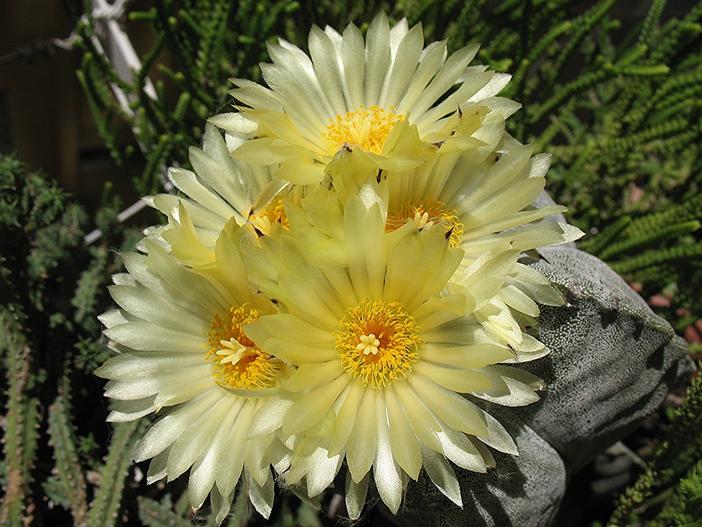Bishop’s Cap Cactus
(Astrophytum myriostigma)
Bishop’s Cap Cactus (Astrophytum myriostigma)
/
/

Resenter1
CC BY 2.0
Image By:
Resenter1
Recorded By:
Copyright:
CC BY 2.0
Copyright Notice:
Photo by: Resenter1 | License Type: CC BY 2.0 | License URL: https://creativecommons.org/licenses/by/2.0/ | Uploader: Resenter1 | Publisher: Flickr






























Estimated Native Range
Summary
Astrophytum myriostigma, commonly known as Bishop’s Cap Cactus, is a spineless cactus native to the arid regions of Northeastern Mexico, particularly found in high-altitude deserts and scrublands. This slow-growing plant is a perennial succulent that can reach a height of 70–100 cm (2 ft 4 in – 3 ft 3 in) and a diameter of 10–20 cm (4–8 in). The cactus is characterized by its three to seven pronounced vertical ribs, which give it a star-like shape in its youth, hence the genus name "astrophytum," meaning "star plant." As the plant matures, it becomes more cylindrical and may develop additional ribs.
The Bishop’s Cap Cactus is admired for its unique appearance and the showy, creamy yellow flowers it produces near the apex, which may have an orange or red base and measure 4–6 cm (1.6–2.4 in) in diameter. Flowering typically occurs in early spring in its native habitat, coinciding with the summer rains that facilitate seed growth. However, in cultivation, flowering can happen in the summer, and plants may take up to six years to flower. This cactus is a popular choice for cactus collections due to its ornamental value and ease of maintenance. It thrives in full sun to part shade and requires very low water, making it suitable for xeriscaping and rock gardens. It prefers well-draining soil and is tolerant of drought once established. While generally disease-free, it can be susceptible to root rot if overwatered. It is not known to be invasive when grown outside its native range.CC BY-SA 4.0
The Bishop’s Cap Cactus is admired for its unique appearance and the showy, creamy yellow flowers it produces near the apex, which may have an orange or red base and measure 4–6 cm (1.6–2.4 in) in diameter. Flowering typically occurs in early spring in its native habitat, coinciding with the summer rains that facilitate seed growth. However, in cultivation, flowering can happen in the summer, and plants may take up to six years to flower. This cactus is a popular choice for cactus collections due to its ornamental value and ease of maintenance. It thrives in full sun to part shade and requires very low water, making it suitable for xeriscaping and rock gardens. It prefers well-draining soil and is tolerant of drought once established. While generally disease-free, it can be susceptible to root rot if overwatered. It is not known to be invasive when grown outside its native range.CC BY-SA 4.0
Plant Description
- Plant Type: Succulent
- Height: 1-2 feet
- Width: 0.4-0.6 feet
- Growth Rate: Slow
- Flower Color: Yellow
- Flowering Season: Spring, Summer
- Leaf Retention: Evergreen
Growth Requirements
- Sun: Full Sun, Part Shade
- Water: Very Low, Low
- Drainage: Fast
Common Uses
Drought Tolerant, Fragrant, Low Maintenance, Rock Garden, Showy Flowers, Street Planting
Natural Habitat
Native to high-altitude deserts and scrublands in Northeastern Mexico
Other Names
Common Names: Bishop’s Hat , Bishop’s Miter Cactus
Scientific Names: Astrophytum myriostigma , Astrophytum quadricostatum , Astrophytum myriostigma var. nudum , Astrophytum myriostigma var. columnare , Astrophytum myriostigma var. quadricostatum , Astrophytum myriostigma var. potosinum , Echinocactus myriostigma , Astrophytum myriostigma var. strongylogonum , Astrophytum myriostigma subsp. glabrum , Astrophytum myriostigma subsp. tulense
GBIF Accepted Name: Astrophytum myriostigma Lem.